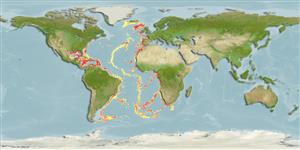Environment: milieu / climate zone / depth range / distribution range
Écologie
marin bathydémersal; non migrateur; profondeur 770 - 2745 m (Ref. 3587). Deep-water
Atlantic Ocean: Eastern Atlantic: off Mauritania, Gulf of Guinea, off Morocco and Madeira; also off Cape Town, South Africa (Ref. 11953). Western Atlantic: Straits of Florida, Gulf of Mexico, and Caribbean Sea. Often confused with Bathygadus melanobranchus Vaillant, 1888.
Taille / Poids / Âge
Maturity: Lm ? range ? - ? cm
Max length : 46.5 cm TL mâle / non sexé; (Ref. 3587)
Épines dorsales (Total) : 2; Rayons mous dorsaux (Total) : 132 - 134; Épines anales: 0; Rayons mous anaux: 130. The head is relatively large; eyes also large. Body tapers abruptly from behind the pectoral fin. Caudal fin absent (Ref. 2800).
Life cycle and mating behavior
Maturities | Reproduction | Spawnings | Egg(s) | Fecundities | Larves
Cohen, D.M., T. Inada, T. Iwamoto and N. Scialabba, 1990. FAO species catalogue. Vol. 10. Gadiform fishes of the world (Order Gadiformes). An annotated and illustrated catalogue of cods, hakes, grenadiers and other gadiform fishes known to date. FAO Fish. Synop. 125(10). Rome: FAO. 442 p. (Ref. 1371)
Statut dans la liste rouge de l'IUCN (Ref. 130435)
Menace pour l'homme
Harmless
Utilisations par l'homme
Pêcheries: d'intérêt potentiel
Outils
Articles particuliers
Télécharger en XML
Sources Internet
Estimates based on models
Preferred temperature (Ref.
123201): 3.7 - 7, mean 4.4 °C (based on 482 cells).
Phylogenetic diversity index (Ref.
82804): PD
50 = 0.5001 [Uniqueness, from 0.5 = low to 2.0 = high].
Bayesian length-weight: a=0.00372 (0.00141 - 0.00980), b=3.11 (2.88 - 3.34), in cm total length, based on LWR estimates for this (Sub)family-body shape (Ref.
93245).
Niveau trophique (Ref.
69278): 3.2 ±0.3 se; based on size and trophs of closest relatives
Fishing Vulnerability (Ref.
59153): Moderate vulnerability (37 of 100).
